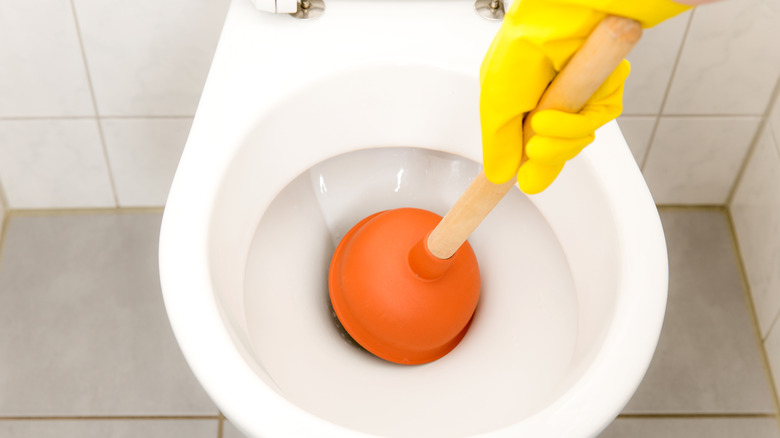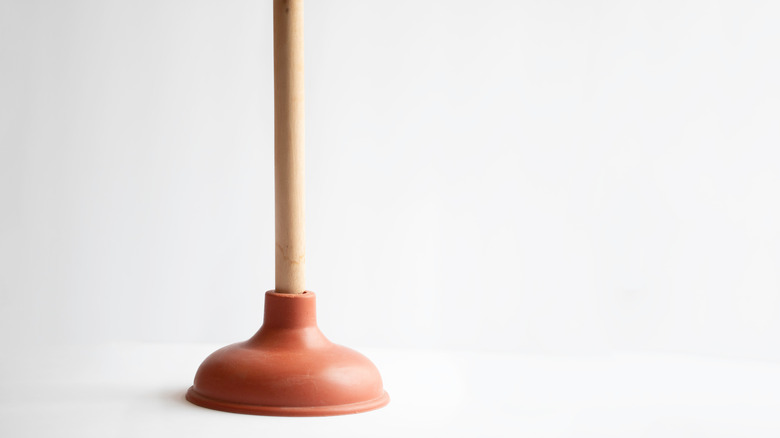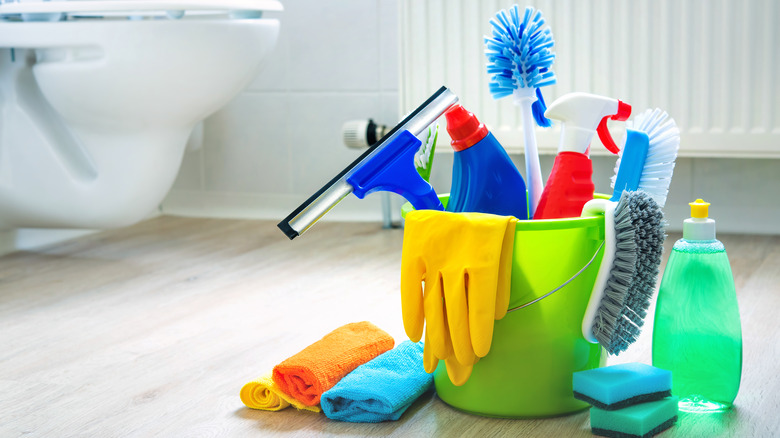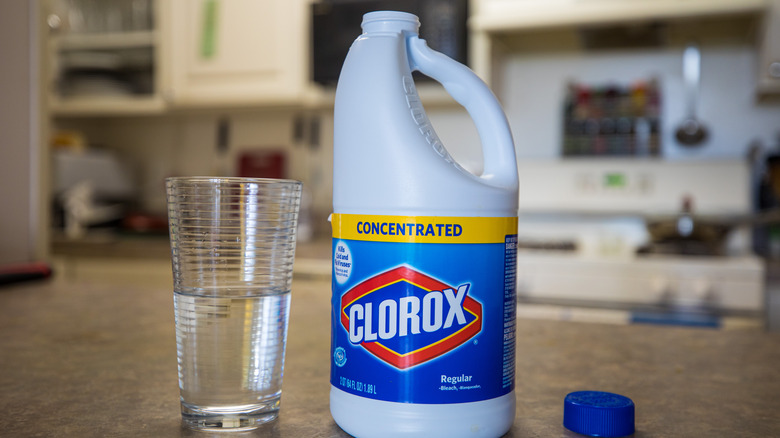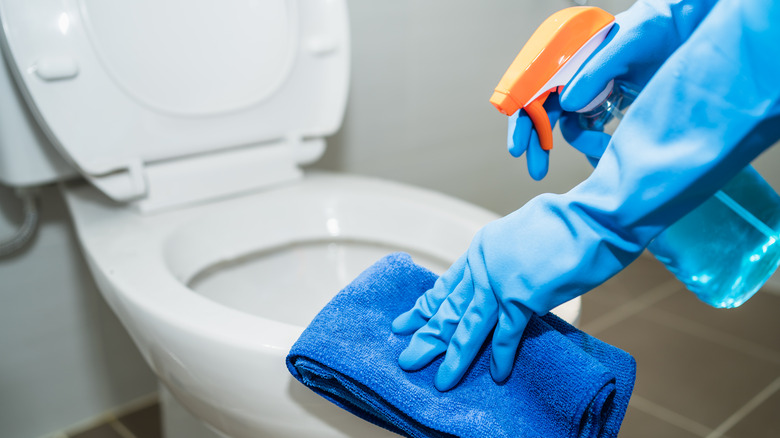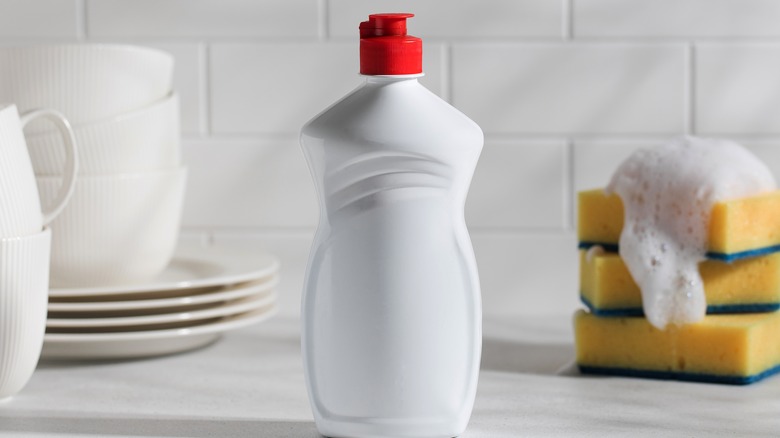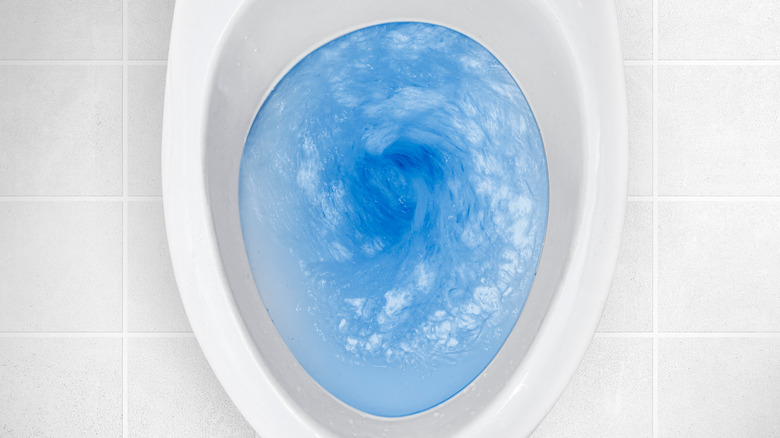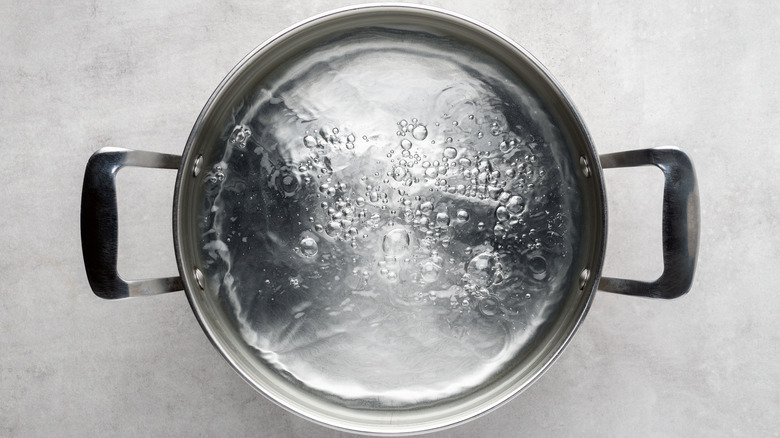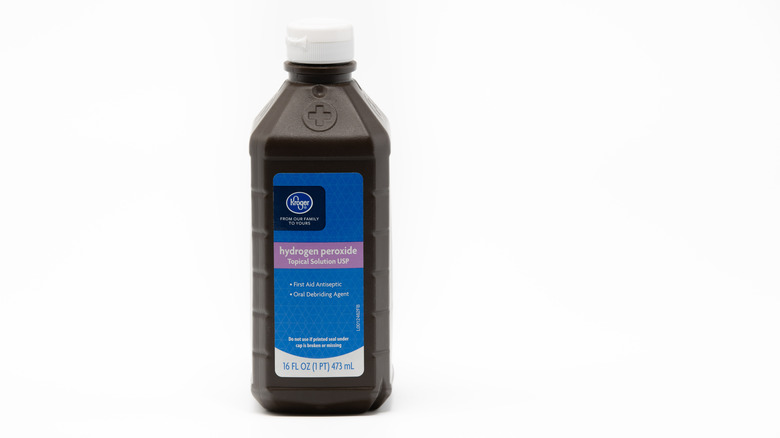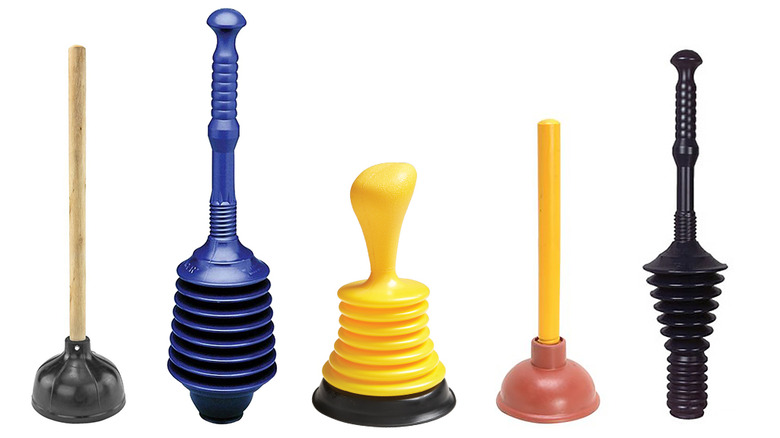How To Properly Clean A Toilet Plunger
Some homeowners find joy in cleaning their homes. Dusting shelves, vacuuming carpets, and cleaning tabletops can all bring a sense of instant satisfaction to nesters. However, there are some spaces in the home that simply aren't fun to clean. And toilets are certainly one of those spaces. In fact, according to a recent study from the New York Post, cleaning the toilet is America's most disliked chore, followed closely by cleaning the oven, removing hair from a drain, and unclogging the sink. There could be several reasons for America's dislike of cleaning toilets. Toilets are awkwardly shaped and it can be difficult to clean around the back. Pesky mineral deposits can leave unsightly stains in a toilet bowl making them even more difficult to clean. And there are so many cleaning supplies available for toilet cleaning, choosing the right option can feel overwhelming.
Despite American's disdain for cleaning toilets, the bathroom is actually the second cleanest room in most households according to the same study, second only to the kitchen. Based on those statistics, homeowners are (thankfully) cleaning their toilets even if they aren't entirely happy about it. However, there's one bathroom tool that even the most diligent cleaner often forgets to tackle — the toilet plunger. The plunger often saves the day when it comes to unexpected toilet clogs. However, they are often neglected when it comes time to clean the bathroom. This neglect can lead to major health concerns. To help you avoid potential hygiene issues and to help keep your bathroom as clean as it can be, we've compiled a list of seven easy ways to properly clean a toilet plunger, for the next time you're tackling a bathroom cleaning.
Many people neglect their toilet plunger
Despite a dedication to bathroom cleanliness, many people forget to clean their toilet plungers. In fact, many homeowners use a toilet plunger to unclog their toilet and then set the plunger back down on the bathroom floor, per The Cleaning Institute. This can cause major hygiene problems because it leaves toilet germs free to spread across your bathroom floor. Imagine stepping out of your shower feeling nice and clean and then walking onto a floor covered in germs spread by your uncleaned toilet plunger. Envision taking a relaxing bath, washing away all the day's stresses, and then stepping out onto a germ-infested bathroom floor. Actually, don't imagine any of that! It's far too cringeworthy to think about. Instead, follow these seven easy methods for how to clean a toilet plunger. Each step is easy to follow, only takes a few minutes to complete, and only requires simple household cleaning items.
Once you give these methods a try, you may feel inspired to deep clean everything in your bathroom!
Seven ways to clean a toilet plunger
Dirty bathroom supplies can make even the most beautiful home appear less valuable, per Ophardt Hygiene. Most people neglect to clean their toilet plunger not because they don't care about germs but because they don't know how to properly clean the tool. In addition to being awkwardly-shaped, plungers are made of different materials, so figuring out how to clean them can be confusing. Additionally, there are so many different cleaning products available today, it can be difficult to choose the most effective options. However, these seven methods make the process easy for every homeowner. You can use conventional cleaning supplies that will definitely deep-clean the plunger, or you can use organic substances mixed with water to help strip away all the dirty plunger germs. And each method only takes a few minutes to complete. So, homeowners can use the plunger to unclog a toilet, clean the plunger, and set it back in the bathroom all in under approximately 30 minutes.
Here's a list of all the supplies included in these methods. You can choose one method or try all of them to determine which one works best for you:
1.) A toilet plunger
2.) A toilet bowl
3.) White distilled vinegar
4.) Chlorine bleach
5.) An aerosol disinfectant
6.) Dish soap
7.) Detergent
8.) A pot to boil water
9.) Hydrogen peroxide
10.) A bucket
1.) Soak the plunger in vinegar
Many homeowners have a bottle of vinegar sitting in their kitchen cabinet right now. The bottle is probably only pulled from the cupboard to make salad dressings, marinades, or other food recipes. However, vinegar has far more uses than just recipes, including household cleaning supplies. Vinegar can be used as a powerful disinfectant because it contains acetic acid, per Healthline. What is acetic acid? It's the colorless organic compound that brings a sour taste and bold smell to vinegar. And because vinegar has an acidic nature, it's often used as a key ingredient in some store-bought household cleaners. Vinegar is strong enough to dissolve dirt, grease, mineral deposits, and grime. It's also powerful enough to kill bacteria. All while also being a naturally derived substance that doesn't contain any harmful chemicals. As many food-enthusiasts may know, there are several different types of vinegars to choose from including white distilled vinegar, apple cider vinegar, balsamic vinegar and red or white wine vinegar. Bonus: Vinegar can also be used to get rid of those pesky mineral deposits from hard water on your toilets and in your shower.
So, what's the best type of vinegar to use for cleaning a toilet plunger? Because we want to avoid staining surfaces with a darker-colored vinegar, white distilled vinegar is the best option for cleaning a toilet plunger. Additionally, white distilled vinegar has almost 5 percent acidity, which is close to the acidity level in many store-bought multipurpose cleaners. If the smell of white vinegar is too potent, you can use apple cider vinegar instead. However, you'll want to dilute the apple cider vinegar with water to avoid staining any surfaces. Once you're chosen your vinegar, start cleaning your plunger.
1.) Start by pouring either white vinegar or apple cider vinegar mixed with water into a large bucket.
2.) Soak the plunger in the bucket of vinegar and swirl the plunger for about 2 minutes.
3.) Remove the plunger from the vinegar and insert the plunger into clean toilet water. Flush the toilet to clean the vinegar off the plunger.
4.) Let the clean plunger dry and place it back near the toilet or wherever you store the plunger.
2.) Swirl in chlorine bleach
Bleach can be a highly effective way to disinfect objects and surfaces, per the CDC. Homeowners have been using bleach to clean kitchen and bathroom surfaces for years. So, using bleach to clean your toilet plunger can be a powerful way to get rid of any lingering germs. However, it's important to take a few precautions while using bleach. First, never mix bleach with ammonia. If possible, wear rubber gloves and eye protection while working with bleach. Using bleach to clean your toilet plunger is extremely easy and only requires bleach, your toilet plunger, and your toilet. Here is the best method for cleaning a toilet plunger with bleach:
1.) Add about 3 capfuls of bleach to clean toilet water.
2.) Use your toilet plunger to swirl the bleach in the water.
3.) Swirl the toilet plunger in the water for about two minutes.
4.) Flush the toilet to remove the bleach from the toilet plunger.
5.) Set the plunger aside to dry and then place it back near the toilet or wherever you store the plunger.
3.) Spray with an aerosol disinfectant
According to a recent American Cleaning Institute survey, 42 percent of Americans aren't using disinfectants properly, per Reader's Digest. A few common mistakes include not letting the disinfectant spray sit long enough on the surface you're trying to clean, not spraying enough onto a surface, and not checking the expiration date. So, before you go any further with cleaning your toilet plunger using disinfectant spray, double-check the expiration date on your spray. Is your spray still good? Okay, then keep reading. Disinfectant spray can be a great cleaning agent for toilet plungers because it doesn't require you to get very close to the plunger at all. Here is how to clean your toilet plunger using disinfectant spray:
1.) Spray your toilet plunger with disinfectant spray and let it sit. Depending on the product, the time to wait can be from 30 seconds to 10 minutes. The label on the spray that you use will always tell you the suggested wait time.
2.) Once your toilet plunger has sat with the disinfectant spray, place the toilet in clean toilet water and flush the toilet to rinse off all the disinfectant spray.
3.) Let the plunger dry and then place it back next to the toilet or wherever your store the toilet plunger.
4.) Clean with dish soap
A simple soap and water solution has been a go-to cleaning method for generations. And there's a reason for this — it works! For this reason, we're including the soap and water method on our list of ways to clean a toilet plunger. This method is for anyone who doesn't want to deal with the hassle of having to pick up another cleaning solution just to clean a toilet plunger. Here is the simple and quick way to clean a toilet plunger using soap.
1.) Mix some dish soap with water in a bucket. Using hot water can be a more effective way to kill germs, per Insider.
2.) Add your toilet plunger into the bucket of water and swirl for about 30 seconds.
3.) After you've finished swirling, let the toilet plunger sit in the soapy water for about five minutes.
4.) Once the toilet plunger has sat in the soapy water for five minutes, place the plunger into clean toilet water and flush the toilet to remove any excess soap suds.
5.) Let the plunger dry and then place it back wherever you store your toilet plunger.
5.) Swirl in a detergent and chlorine bleach mix
Detergents were developed during World War II as a response to a shortage of the animal and vegetable fats needed to make soap, per ThoughtCo. What makes detergents different from soap is that they are mostly surfactants, which in non-technical terms, make surfaces "wetter" so that the detergent is less likely to stick to itself or the surface and more likely to interact with grease, oil and dirt. For this reason, detergents can be a powerful cleaning substance for cleaning toilet plungers. Additionally, traditional cleaning supplies such as chlorine bleach can emit a potent smell. To reduce the intensity of the bleach smell, cut the chlorine bleach used to clean a toilet plunger with detergent to about a quarter of a cup. Here's how to use a chlorine bleach/detergent solution to clean a toilet plunger.
1.) Mix detergent and bleach in clean toilet water, and swirl the plunger around to clean and disinfect it.
2.) Continue to swirl the plunger for about two minutes.
3.) Flush the toilet so that all the excess cleaning mixture is removed from the plunger.
4.) Tap the plunger on the side of the toilet to remove excess liquid.
5.) Set the plunger aside to dry and then return the toilet plunger to wherever you store it.
6.) Use boiling water
Sometimes accidents happen at the most inconvenient times. Maybe you have to unclog your toilet only to realize that you are completely out of cleaning supplies to use to disinfect your toilet plunger. If this is the case, there is still a cleaning option available. Simply use some boiling water to kill any bacteria on the toilet plunger. Here's how to do it.
1.) Boil a pot of water.
2.) Use a pot holder to grab the pot of water and pour some of the water in to a cup or smaller carrying device.
3.) Place the toilet plunger into the toilet and carefully pour some boiling water onto the plunger. Be sure to allow the boiling water to flow all over the plunger including the areas within the cup.
4.) Once all surfaces of the plunger have been covered with boiling water, flush the plunger in clean toilet water.
5.) Tap the plunger to dry and then place it back into storage.
Although boiling water can be an effective way to kill germs, this should be used to clean your toilet plunger as a last resort when more sophisticated methods of disinfection are not available, per OAS. Using a vinegar, soap, detergent or other disinfectant is a more effective way to ensure that your toilet plunger is completely clean.
7.) Clean with hydrogen peroxide
Hydrogen peroxide offers a vast array of household uses, according to WebMD. Some of these uses include cleaning cuts, removing earwax, healing swollen gums and canker sores, whitening teeth, lightening hair, and reducing acne. However, perhaps the most effective use for hydrogen peroxide is as a disinfectant. A 3% solution of hydrogen peroxide, the type commonly found in stores, works great for household cleaning and disinfecting. Some people even use hydrogen peroxide to sanitize beauty and manicure tools. So, after you finish whitening your teeth and cleaning your makeup brushes, you can get to work on the toilet plunger. Here's how to clean a toilet plunger with hydrogen peroxide.
1.) Pour a 1/2 cup of hydrogen peroxide into the toilet bowl.
2.) Place the toilet plunger into the toilet bowl and let it sit in the hydrogen peroxide water for about 30 minutes.
3.) After the plunger has sat for 30 minutes, flush the toilet with clean water to remove any excess disinfectant.
4.) Tap the plunger on the side of the toilet to remove any excess water.
5.) Let the plunger dry and then place it back in storage.
The 3 types of toilet plungers and how to clean them
Toilet plungers are far more advanced than most people probably realize. In fact, toilet plungers aren't even limited to just one type anymore. There are actually three different types of plungers available today and they each have their own unique use, per Arrow Plumbing. Here is everything you need to know about the three different types of plungers and how to clean them.
1.) The Cup Plunger. The common cup plunger is probably the first thing you think of when you think about toilet plungers. The handle is a long and straight piece of wood or metal with a cupped rubber plunge at the end. Although this is the plunger most commonly associated with toilet plungers, it was actually designed to unclog other drains and isn't necessarily the most effective for toilets. Because the plunger cup was designed with a flat bottom, the cup plunger is best suited for flat surfaces including kitchen sinks, bathroom sinks, and bathtub drains. This doesn't mean it won't work in toilets, it's simply not the absolute best option.
2.) The Flange Plunger. This is the holy grail of plungers. Not only is it designed specifically for toilets, but it can also be converted for use on kitchen sinks, bathroom sinks, and toilet drains. The flange plunger also has a cup like the common cup plunger. However, the flange plunger also includes a soft rubber flap that folds out from inside the cup. This flap fits perfectly over a toilet drain so that it easily forms the necessary suction to clear a clog. Homeowners can easily convert the flange plunger into a common cup plunger by folding the flap inside the cup. The flange plunger provides the flexibility for use on any type of drain and clog.
3.) The Accordion Plunger. This type of plunger is also designed for toilet clogs. However, it's not as widely used as the flange plunger. The accordion plunger is made completely of plastic and is molded with several flexible accordion-style ridges and a small cup on the bottom. The way the accordion plunger works is by holding air within the accordion folds of the plunger. When the plunger presses against the toilet drain, the compressed air shoots out of the plunger and down the drain, usually dislodging the clog. Some people believe that the accordion plunger is even more effective than the flange plunger. However, it's also a little more complicated and takes a little longer to figure out how to use. So, it's not always a homeowner's first choice.
How do you clean each of these toilet plungers? Good news — all of the cleaning methods listed above can be used on each of these different toilet plungers.
